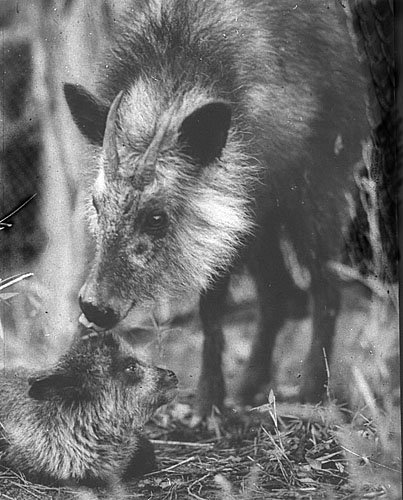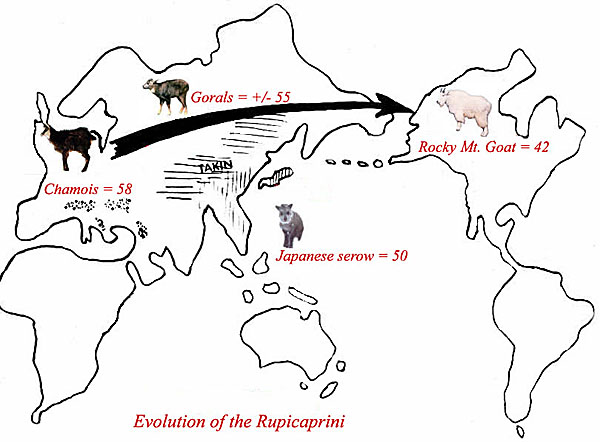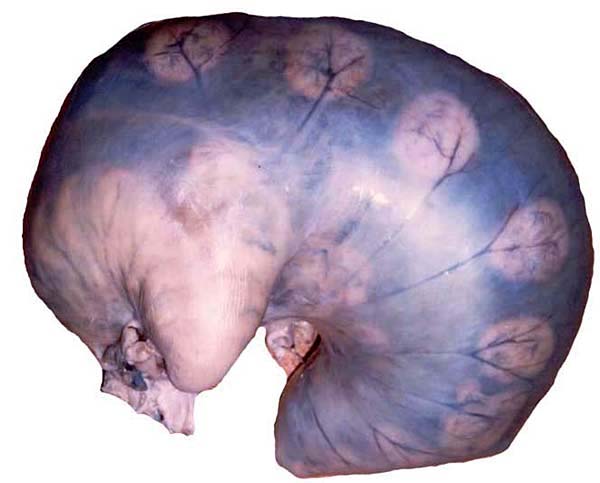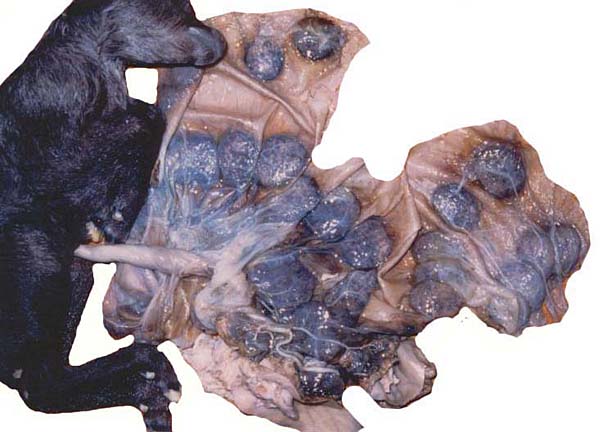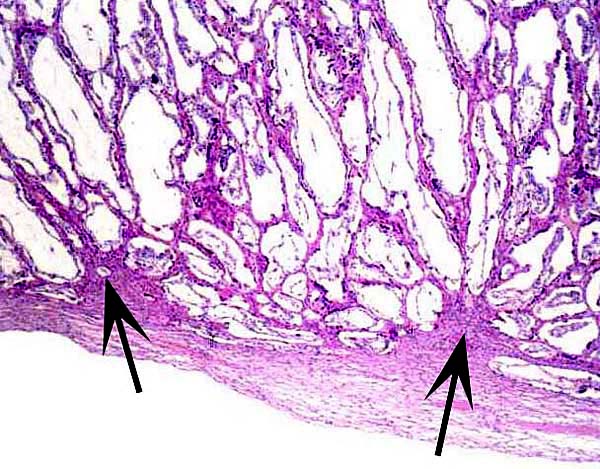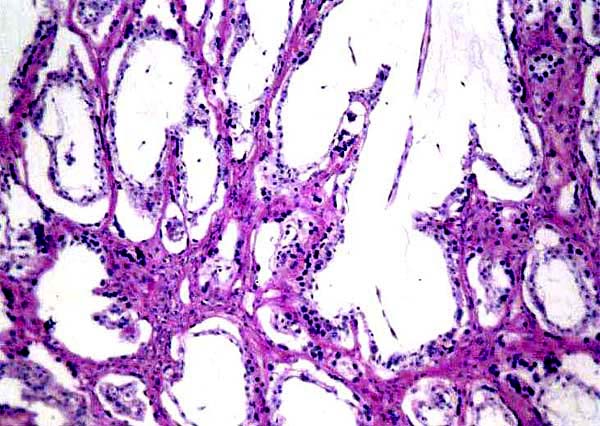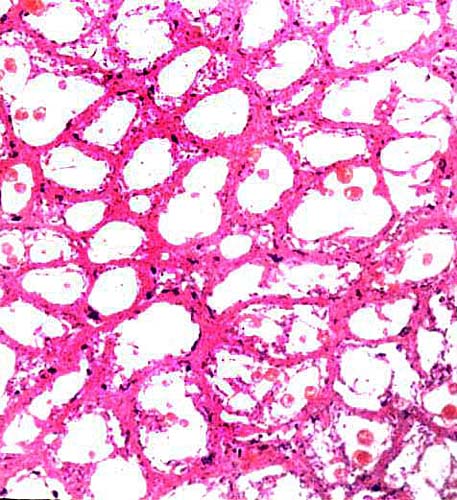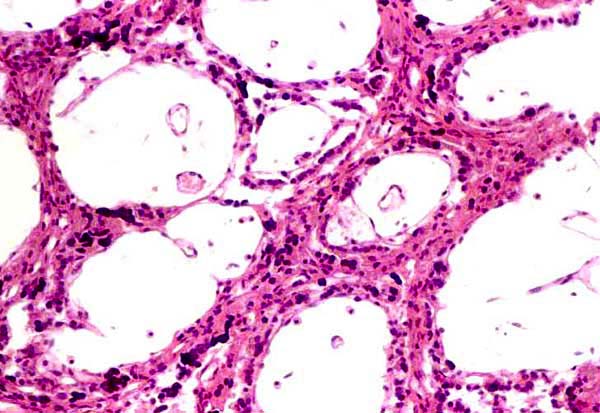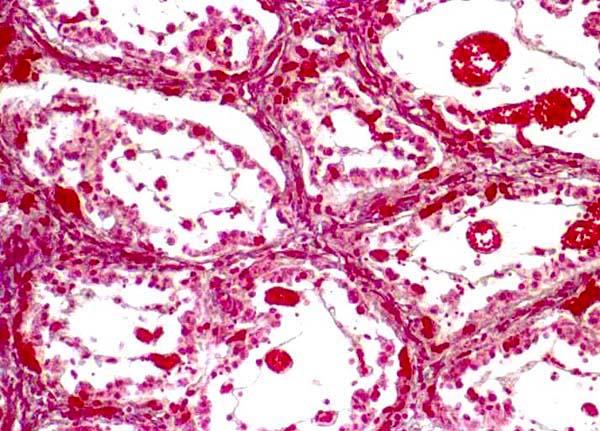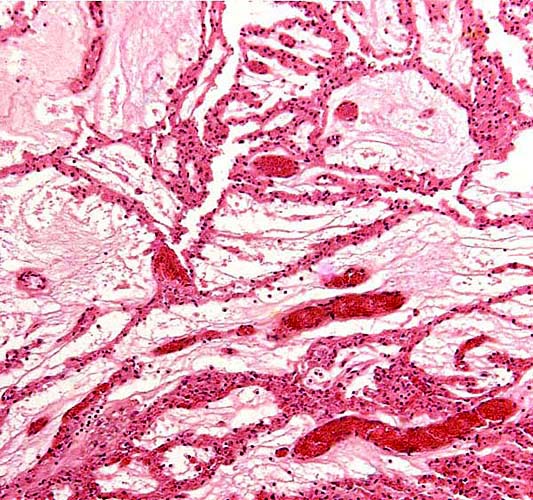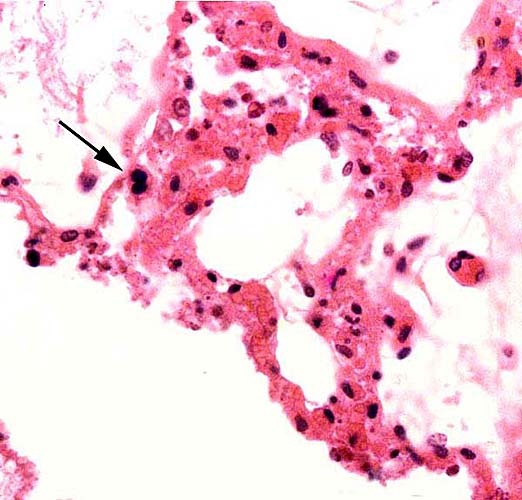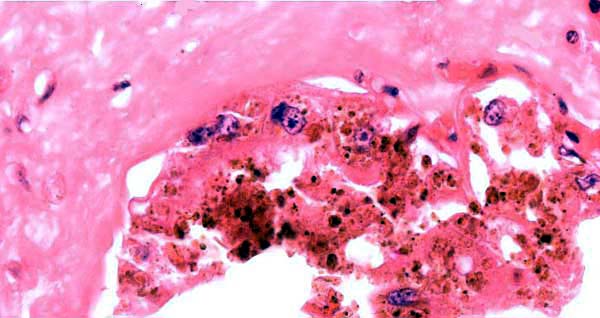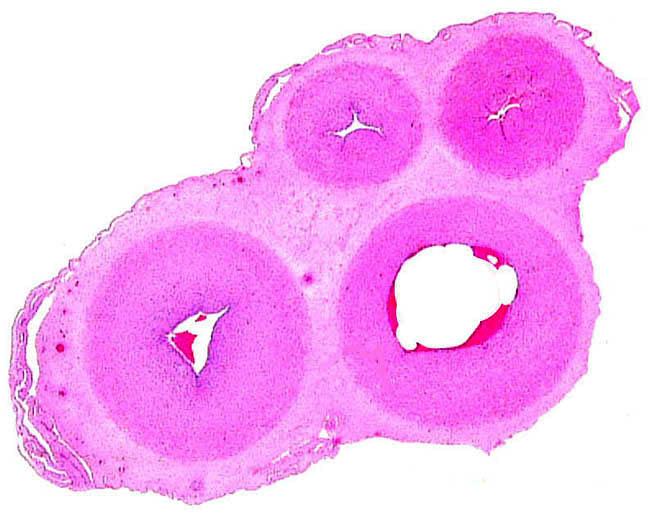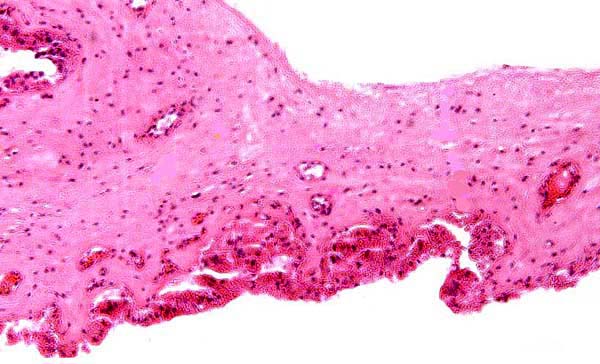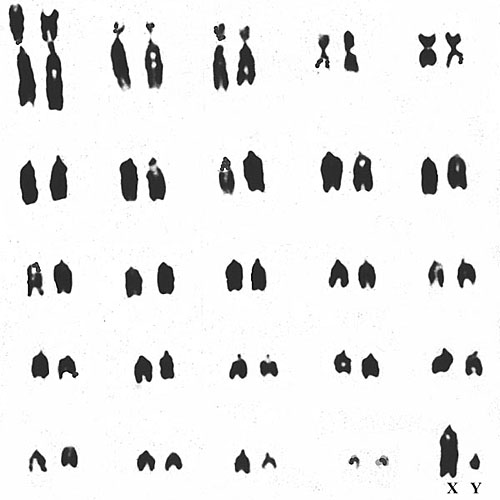14) Immunology
Sugimura et al. (1990) described the composition of lymph nodes in a variety of animals, including the serow, but we are not aware of any other immunological studies, other than surveys. Thus, Inoshima et al. (1999; 2001) surveyed Japanese serows and found a 20% immune response to parapox virus.15) Pathological features
A macerated fetus was found by Yamamoto et al. (1994) among "2,138 pregnant Japanese serows". The fetus appears to have been retained, as all placentomes had disappeared and there was an inflammatory reaction. Parapoxvirus infection of the interdigital glands was found in a wild serow by Suzuki et al. (1997a). Numerous parasites have been identified in serows, thus: Inoue (1989) found four species of Eimeria that were non-infectious for goats; Gongylonema was identified by Chakraborty (1994); Inoue & Imura (1991) identified Eimeria gozaishoensis in a Formosan serow, and Uni et al. (2001, 2002) isolated several Cercopithifilaria species from Japanese serows. A wild serow with dermatitis was found to suffer from infection by Chorioptes bovis, apparently a new host for this mite (Shibata et al., 2003). Onchocerca was found to cause lesions of the ligaments to the olecranon, with chronic tendonitis (Suzuki et al., 1997b).16) Physiologic data
The serow in Japan is protected and at the same time it is pursued because of its raiding crops. Therefore, Deguchi et al. (2001) conducted a study to ascertain food preferences. They found that the animals prefer crop rather than wild plants and inferred that this relates to the higher protein content of crops.
A large number of anatomical studies have been performed on this rare animal. Yamamoto et al. (1998) and Kitamura et al. (2003) described the microscopic findings of the forestomach anatomy. Atoji et al. (1996) found significant differences in the structure of the infraorbital glands of Formosan and Japanese serows. The masseter muscle structure was described by Suzuki (1989), and the interdigital gland of a Formosan serow was described by Atoji et al. (1995) and compared with that of a Japanese serow (Atoji et al., 1987). Bronchial tree and lungs were examined by Nakakuki (1986). Atoji et al. (1987a) studied the brachial plexus and later, the lumbosacral plexus of Japanese serows (1987b). The same authors also examined the histology of preputial glands (Atoji et al., 1989). Takahashi et al. (1984) determined the lipid composition of red cell membranes in serows, and Kita et al. (1995) described mammary glands and teats.17) Other resources
Cell strains of fibroblasts are available from CRES at the San Diego Zoo by contacting Dr. Oliver Ryder at oryder@ucsd.edu.
18) Other remarks - What additional Information is needed?
No early stages of implantation have been described and would be desirable to obtain. Endocrine studies during pregnancy are needed.
Acknowledgement
The first animal photograph in this chapter comes from Mr. Takeuchi at the Japan Serow Center, Gozaisho Mountain, Japan.
References
Atoji, Y., Hori, Y., Sugimura, M. and Suzuki, Y.: Lectin histochemical study on the
infraorbital gland of the Japanese serow (Capricornis crispus). Acta Morphol. Neerl. Scand. 25:201-213, 1987.
Atoji, Y., Suzuki, Y. and Sugimura, M.: The brachial plexus of the Japanese serow
(Capricornis crispus). Anat. Anz. 163:25-32, 1987a.Atoji, Y., Suzuki, Y. and Sugimura, M.: The lumbosacral plexus of the Japanese serow, Capricornis crispus. Anat. Anz. 164:213-217, 1987b.
Atoji, Y., Suzuki, Y. and Sugimura, M.: Lectin histochemistry of the interdigital gland in the Japanese serow (Capricornis crispus) J. Anat. 161:159-170, 1988.
Atoji, Y., Suzuki, Y. and Sugimura, M.: The preputial gland of the Japanese serow
Capricornis crispus: ultrastructure and lectin histochemistry. Acta Anat. 134:245-252, 1989.
Atoji, Y., Yamamoto, Y. and Suzuki, Y.: Morphology of the interdigital glands of a
Formosan serow (Capricornis crispus swinhoei). J. Vet. Med. Sci. 57:963-964, 1995.
Atoji, Y., Yamamoto, Y. and Suzuki, Y.: Infraorbital glands of a male Formosan serow (Capricornis crispus swinhoei). Eur. J. Morphol. 34:87-94, 1996.Benirschke, K.: The Japanese serow. ZooNooz 46:14?17, 1973.
Benirschke, K., Soma, H. and Ito, T.: The chromosomes of the Japanese serow,
Capricornis crispus (Temminck). Japan Acad. 48:608?612, 1972.Benirschke, K. and Soma, H.: The Japanese serow. Life Sciences 10:1?4, 1972 (Japanese).
Chakraborty, A.: Occurrence and pathology of Gongylonema infection in captive
herbivores. Vet. Parasitol. 52:163-167.
Chikuni, K., Mori, Y., Tabata, T., Saito, M., Monma, M. and Kosugiyama, M.: Molecular phylogeny based on the ?-casein and cytochrome b sequences in the mammalian suborder Ruminantia. J. Mol. Evol. 41:859-866, 1995.
Deguchi, Y., Sato, S. and Sugawara, K.: Relationship between some chemical components of herbage, dietary preference and fresh herbage intake rate by the Japanese serow. Appl. Anim. Behav. Sci. 73:69-79, 2001.
Dolan, J.: Beitrag zur systematischen Gliederung des Tribus Rupicaprini Simpson. Z. Zool. Syst. Evolutionsforsch. 1:311-407, 1963.
Hashiguchi, K. and Hashimoto, K.: The mineralization of crystalline inorganic components in Japanese serow horn. Okajimas Folia Anat. Jpn. 72:235-243, 1995.
Inoshima, Y., Shimizu, S., Minamoto, N., Hirai, K. and Sentsui, H.: Use of protein AG in an enzyme-linked immunosorbent assay for screening for antibodies against parapoxvirus in wild animals in Japan. Clin. Diagn. Lab. Immunol. 6:388-391, 1999.
Inoshima, Y., Yamamoto, Y., Takahashi, T., Shino, M., Katsumi, A., Shimizu, S. and Sentsui, H.: Serological survey of parapoxvirus infection in wild ruminants in Japan in 1996-1999. Epidemiol. Infect. 126:153-156, 2001.
Inoue, I.: Eimeria Capricornis n .sp., E. nihonis n. sp., E. naganoensis n. sp. and E. kamoshika n. sp. (Protozoa; Eimeridae) from the Japanese serow, Capricornis crispus. Nippon Juigaku Zasshi. 51:163-168, 1989.
Inoue, I. and Imura, M.: Eimeria gozaishoensis n. sp. from the Formosan serow
(Capricornis crispus swinhoei). J. Wildl. Dis. 27:214-216, 1991.
Ito, T., Soma, H. and Benirschke, K.: The chromosomes complement of the Japanese serow, Capricornis crispus crispus. Mammalian Chromosomes Newsletter 13:12?13, 1972.
Jones, M.L.: Longevity of ungulates in captivity. Intern. Zoo Yearb. 32:159-169, 1993.Kita, I., Miura, S., Kojima, Y. and Tiba, T.: Macroscopic observations of mammary glands and teats of Japanese serows, Capricornis crispus, with special reference to past gestation. J. Vet. Med. Sci. 57:447-451, 1995.
Kitamura, N., Yoshiki, A., Sasaki, M., Baltazar, E.T., Honda, E., Yamamoto, Y., Agungpriyono, S. and Yamada, J.: Immunohistochemical evaluation of the muscularis mucosae in the ruminant forestomach. Anat. Histol. Embryol. 32:175-178, 2003.
Nakakuki, S.: The bronchial tree and blood vessels of the Japanese serow lung. Anat. Anz. 161:61-68, 1986.
Nowak, R.M.: Walker's Mammals of the World. 6th ed. The Johns Hopkins Press, Baltimore, 1999.Shibata, A., Yachimori, S., Morita, T., Kanda, E., Ike, K. and Imai, S.: Chorioptic mange in a wild Japanese serow. J. Wildl. Dis. 39:437-440, 2003.
Soma, H.: and Kada, H.: Evolutionary pathway of chromosomes of the Capricornis. Chapter 11, pp. 109-118, in, One Medicine, O.A. Ryder and M.L. Byrd, eds. Springer-Verlag, Berlin, 1984.
Soma, H. Kada, H. Matayoshi, K. Evolutionary pathways of karyotypes of the tribe Rupicaprini. In Soma, H. (ed) The Biology and management of Capricornis and Related Mountain Antelopes. Croom Helm, London, 62-71, 1987.
Sugimura, M., Suzuki, Y., Kamiya, S. and Fukita, T.: Reproduction and prenatal growth in the wild Japanese serow, Capricornis crispus. Nippon Juigaku Zasshi. 43:553-555, 1981.
Sugimura, M., Shirogane, D., Atoji, Y., Suzuki, Y., Ohshima, K., Kon, Y. and Hashimoto, Y.: A comparative study on S-100 protein-immunoreactive cells in lymph nodes. Nippon Juigaku Zasshi 52:1015-1021, 1990.
Suzuki, T.: The lamination of the masseter muscle in the Japanese serow (Capricornis crispus). Okajimas Folia Anat. Jpn. 65:381-389, 1989.
Suzuki, Y., Komatsu, T., Yamamoto, Y. and Atoji, Y.: Pathology of interdigital glands in a wild Japanese serow (Capricornis crispus) infected with parapoxvirus. J. Vet. Med. Sci. 59:1063-1065, 1997a.
Suzuki, Y., Uni, S., Komatsu, T., Yamamoto, Y. and Atoji, Y.: Olecranon lesions caused by Onchocerca skrjabini in wild Japanese serows (Capricornis crispus). J. Vet. Med. Sci. 59:387-390, 1997b.
Takahashi, M., Imai, A., Nakashima, S. and Nozawa, Y.: Phospholipid and fatty acid composition of erythrocyte membrane from wild Japanese serow (Capricornis crispus). Comp. Biochem. Physiol. B 77:369-371, 1984.
Uni, S., Suzuki, Y., Baba, M., Mitani, N., Takaoka, H., Katsumi, A. and Bain, O.: Coexistence of five Cercopithifilaria species in the Japanese rupicaprine bovid, Capricornis crispus. Parasite 8:197-213, 2001.
Uni, S., Bain, O., Takaoka, H., Katsumi, A., Fujita, H. and Suzuki, Y.: Diversification of Cercopithifilaria species (Nematoda: Filaroidea) in Japanese wild ruminants with description of two new species. Parasite 9:293-304, 2002.
Yamamoto, Y., Atoji, Y., Kita, I. and Suzuki, Y.: Maceration of fetus in the Japanese serow (Capricornis crispus). J. Vet. Med. Sci. 56:165-166, 1994.
Yamamoto, Y., Atoji, Y., Agungpriyono, S... and Suzuki, Y.: Morphological study of the forestomach of the Japanese serow (Capricornis crispus). Anat. Histol. Embryol. 27:73-81, 1998.
|

